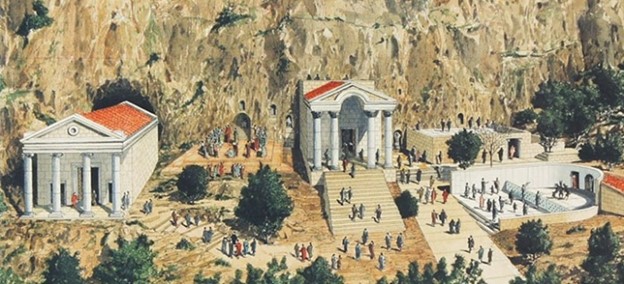
For the four weeks leading up to and going beyond Easter, we’re looking at the life of Peter. Because he’s so often at the center of both the brightest and darkest moments in the Gospels, he has always been a source of hope and inspiration for those endeavoring to follow Jesus.
It’s hard to visit Washington D.C. and not think, “This is a place where important things happen.”
The marble buildings and monuments evoke both memories and aspirations. The White House is the ultimate symbol of world leadership. A glance at the Capitol brings to mind America’s commitment to the rule of law, but also the rancor of political debate and grass roots protests. The Supreme Court evokes the tensions of life-and-death cultural issues yet to be satisfactorily resolved.
We can picture Martin Luther King, Jr., standing on the steps of the Lincoln Memorial saying, “I have a dream.” And over there, just a few blocks away, we know that a commercial airliner slammed into the Pentagon – evidence that while many in the world see America’s capital as a source of hope, others see it as a place that deserves to be destroyed.
Visitors to Washington are often led to ponder important questions: If America is a great nation, what makes it great? If our nation has a mission, can we ever agree what it is? And who should provide leadership for what we do today and tomorrow?
That’s the power of visiting a place that is laden with historical and global significance.
There was a similar place associated with Israel during the first century.
No, it wasn’t Jerusalem – even though most Jews believed their capital city, simply because it had the temple, was the actual center of the earth. There was another locale, just beyond Israel’s northernmost perimeter, that represented the interface of God’s people with earthly and heavenly powers.
It was Caesarea Philippi, a pagan city that had recently been renamed and refurbished by Philip, one of the many descendants of Herod the Great. Over the centuries, the area had become notorious as a center for idolatry. Statues of various deities dotted a dramatic landscape – all of it dominated by a 100-foot-high sheer cliff at the foot of Mt. Hermon, the highest peak in that part of the world. There was a shrine for the worship of Zeus, and the Dance Floor of the Sacred Goats (don’t ask). The city was originally named Paneas in honor of the Greek god Pan, the “wild child” of woods and pastures. Pan was said to inspire terror in those who accidentally stumbled onto one of his hiding places – hence our word “panic.”
In the midst of this plethora of ancient gods, Philip authorized the worship of Caesar Augustus, the Roman emperor for whom he named the area. About the time Jesus was born, the successors of Julius Caesar had begun to present themselves as divine – despite ample evidence that they were all too human.
Caesarea Philippi was also a special place geographically. It’s the only spot on earth where three continents come together. The ancient International Highway, which connects Africa, Europe, and Asia, skirted the hills just a few miles to the east. In a sense, “the whole world” could be expected to show up sooner or later in this neck of the woods.
As if that weren’t enough, the city was also thought to be where this present world – the world of human beings and their concerns – intersects with the underworld, the realm of evil spirits and the dead. There was (and still is) an enormous cavern, out of which gushes a cold stream. Locals believed that at the back of the cave there was an entrance to Hades. Thus the yawning mouth of the cavern was known as the Gates of Hell.
Heaven and hell, empires and nations, gods and humans – all the Powers That Be were on display in Caesarea Philippi.
If you journeyed to this place in the first century, you might well be led to say, “This is where important things happen.”
Which is almost certainly why Jesus brought his disciples to this place when it was time for a crucial conversation.
“Who do people say the Son of Man is?” (Matthew 16:13) As far as we know, this is the first time Jesus had ever asked this question. He had been coy about his identity, intentionally dampening expectations. But now he wants to know what his apprentices have concluded.
“They replied, ‘Some say John the Baptist; others say Elijah; and still others, Jeremiah or one of the prophets.’” That’s what others are saying. Jesus now makes it personal. “But what about you? Who do you think I am?”
It’s time for a DTR – to “define the relationship.” Twelve men have been following Jesus – listening to his teaching, watching his actions, witnessing his miracles. Now they’re in a place named for a phony emperor-god, with phony idols on the left and phony idols on the right. It’s time to fish or cut bait, paint or get off the ladder. Who exactly do you think I am?
Peter jumps in to fill the silence: “You are the Messiah, the Son of the Living God.”
It’s his greatest moment – and arguably one of the greatest moments in spiritual history.
Tomorrow we’ll take in Jesus’ amazing response.
